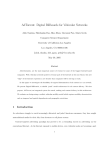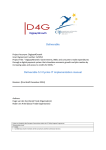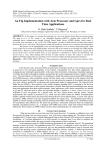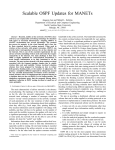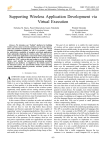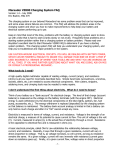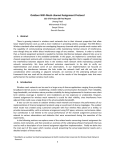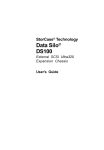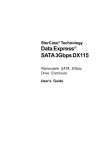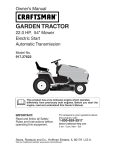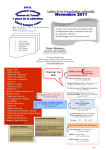Download V2VCOM 2005 - UCLA Computer Science
Transcript
AdTorrent: Digital Billboards for Vehicular Networks
Alok Nandan, Shirshanka Das, Biao Zhou, Giovanni Pau, Mario Gerla
Computer Science Department
University of California Los Angeles
Los Angeles, CA 90095-1596
{alok, shanky, zhb, gpau, gerla}@cs.ucla.edu
Abstract
One of the most important sources of revenue for big
Internet-based companies are advertisements. With vehicular networks poised to become part of the Internet,
this new “edge” of the Internet represents the next frontier that advertising companies will be striving to reach.
In this paper we investigate the feasibility of targeted
dissemination of ad content in a car network. We present
Digital Billboards, a scalable “push” model architecture for ad content delivery. We then propose, AdTorrent,
an integrated system for search, ranking and content delivery in this architecture. We evaluate our design using
a realistic vehicular mobility model which captures mobility characteristics such as temporal and spatial dependencies and geographic restrictions.
1
Introduction
As advertisers struggle to reach increasingly distracted and jaded American consumers, they have
sought nontraditional media for their Ads, from elevators to cell phone screens.
Content-targeted advertising paradigm has proved to
be a resounding success in advertising on the conventional Internet. As the Internet expands to mobile devices, even vehicular nodes are becoming a part of the
”edge” of the Internet. Several interesting challenges in
application design arise, while designing a targeted ad
delivery mechanism for cars.
Consider this scenario; you are driving on Interstate5 from Los Angeles to San Francisco, visiting relatives.
On the way, you realize that you need to buy some gift
for them. You initiate a search for “new DVD releases”.
The Ad software is not only keyword aware but also location aware. Hence the search results return not only
the content or latest DVD releases but also the latest
deals on those DVD releases in stores.
286
Imagine another similar scenario, you are traveling to
Las Vegas. You are 50 miles from the city and want to
get information of all hotels less than 200 dollars cost,
preferably with virtual tours of the hotels.
In this paper we present Digital Billboards, an adservice provider architecture for urban vehicular networks. We use a realistic group-mobility model to evaluate certain key parameters that guide the design of our
advertisement search and delivery service. Finally, we
propose AdTorrent, a location aware advertisement dissemination service for this architecture. The vehicular environment presents interesting challenges and constraints not encountered in content delivery on the Internet. In particular, mobility and the limited/intermittent
bandwidth cause sessions to be transitory and subject to
frequent disconnections.
AdTorrent seeks to provide to the user, relevant Ads
guided by a particular keyword search. Ads potentially
can be multimedia clips, for example, virtual tours of
hotel rooms, trailers of movies in nearby theatres or a
conventional television ad.
Our Contributions Vehicular Ad Hoc Networks
(VANETs) present interesting challenges to protocol design. One of the key differentiating characteristics is the
time-varying nature of vehicle densities and the mobility
model. Mobility has a important impact on application
design.
The contributions of this paper are as follows: (1)
firstly, we propose a novel push-model based locationaware ad service architecture, designed for vehicular environments (2) secondly, we present a group mobility
model for urban vehicular traffic, (3) thirdly, we present
a peer-peer protocol that enables efficient keyword-set
based search. We propose a novel search result ranking
scheme that is optimized for vehicular networks. We
use swarming, to quickly deliver top ranked content to
the end user.
1.1
Organization of the Paper
Table 1. DSRC Characteristics
Value
Parameter
1000m
Range
5.9Ghz
Frequency Band
≤ 85mph
Speed
6-27Mbps(depending on Range)
Data Rates
The rest of the paper is organized as follows. Section 2.1 describes the Vehicular communication architecture. Section 3 gives an overview of the operation
of the ad service in a vehicular scenario. Section 4 describes the novel mobility model we used for the purpose
of evaluation and details our evaluation of the performance of our protocol using simulation. Section 5 gives
a brief overview of AdTorrent, based on a push-model of
content dissemination based on a popular swarming protocol. We outline the related work in section 7. Finally,
Section 8 concludes the paper.
2
2. Storage of data is not constrained: VANETs are
typified by no power constraints and no data storage limitations.
3. Data is meta-tagged: Meta-data can be the filename, the format and/or key-words extracted from
the data. For some types of data, such as text documents, metadata can be extracted manually or algorithmically. Some types of files have metadata
built-in; for example, ID3 tags on MP3 music files.
Preliminaries
In this section we describe the vehicular environment
and the assumptions about the environment we used to
design our protocol.
The network consists of a set of N nodes with same
computation and transmission capabilities, communicating through bidirectional wireless links between each
other, this is the infrastructure-less ad-hoc mode of operation. There are wireless gateways at regular intervals
providing access to the rest of the Internet using infrastructure support(either wired or multi-hop wireless). We
do not assume any routing protocol running in the underlying network. Nodes may or may not run the peer-peer
application protocol. Hence, P the size of the peer-peer
network is such that, P ⊂ N and is established on top
of this vehicular network.
In addition, we assume a CSMA/CA MAC layer protocol(IEEE 802.11a) that provides RTS/CTS-Data/ACK
handshake sequence for each transmission. Nodes use
TCP for reliable transfer of data and UDP for dissemination of index updates. It includes data packets as well
as gossip messages. However, the packet, is the unit for
network layer. We assume each node is reachable to every other node.
Our vehicular wireless architecture is composed of
two kinds of communications, namely, vehicle-vehicle
and vehicle-gateway. Dedicated Short-Range Communication(DSRC) [13] is a short to medium range communication technology operating in the 5.9 GHz range.
The key characteristics of DSRC are given in the table
1. For a more detailed description, we refer the reader
to [17].
2.1
Assumptions
1. Data is not strictly real-time: There are no realtime constraints on the data, thus in some sense,
the data is delay-tolerant.
287
4. Communication between vehicles is over a low
data rate connection: While this constraint depends on the radio technology used. Currently,
802.11x devices will offer goodput of the order of
a few hundred Kbps.
5. Push model: Data is being continually “pushed” by
the access points to the nodes in the transmission
range.
6. Multi-hop delivery: It is infeasible to transmit data
to more than 2-3 hops.
3
The Digital Billboard Architecture
The digital billboard architecture serves to deliver
Ads to the vehicles that pass within the range of the Access Points (APs). This architecture is:
• Safer: Physical billboards can be distracting for
drivers
• Aesthetic: The skyline is not marred by unsightly
boards.
• Efficient: With the presence of a good application
on the client (vehicle) side, users will see the Ad
only if they actively search for it or are interested
in it.
• Localized: The physical wireless medium automatically induces locality characteristics into the advertisements.
Every Access Point (AP) disseminates certain sets of
Ads that are relevant to the proximity of the AP deployment. This is reasonable since it is the extension of the
physical billboards that we very often see lined on the
streets and freeways that advertise the best offers available at the next restaurant. Our AP acts as a “digital billboard”. This model makes sense economically as well
since business owners in the vicinity subscribe to this
digital billboard service for a fee. The APs continually
disseminate these advertisements to the vehicles that traverse the coverage area. The dissemination rate can be
determined by different levels of service demanded and
paid for by the billboard owner.
Leveraging this architecture, we want to design a
location-aware distributed mechanism to search, rank
and deliver content to the end-user (the vehicle). We focus not only on simple text-based Ads but also on larger
multimedia Ads, for example, trailers of movies playing
at the nearby theater, virtual tours of hotels in a 5 mile radius, or conventional television advertisements relevant
to local businesses.
Every node that runs the application collects these advertisements and indexes the data based on certain metadata which could be keywords, location and other information associated with the data. We assume that Ads are
uniquely identifiable using a document identifier (DocId).
In the next section we describe a group mobility
model for an urban vehicular network. The model
guides us in the design of AdTorrent, an application for
advertisement search and delivery on the vehicular network.
4
formed and broken, since the communication pattern is
peer-to-peer.
We used the US Census bureau data for street level
maps. As a starting point we used the script from [3]
paper to generate the mercator projection of the data,
in our case the local map of an area around UCLA in
Figure 1.
Span 2400 m
N 141139 m
S 138739 m
W 54605 m
E 57005 m
Figure 1. Local Map of Westwood, an area
around UCLA
Mobility Model
The mobility model is designed to describe the movement pattern of mobile users, and how their location
and velocity change over time. Mobility patterns play a
significant role in determining the protocol performance
and thus are an important parameter to the protocol design phase. It is important for mobility models to emulate the movement pattern of targeted real life applications in a reasonable way. Otherwise, the observations made and the conclusions drawn from the simulation studies may be misleading. Thus, when evaluating
our vehicular ad hoc network protocol, it is imperative
to choose the proper underlying mobility model. Different application scenarios lend themselves to different
mobility models. For example, a campus-wide wireless
network deployment will see different mobility patterns
(less constrained, more random) than an urban vehicular
grid scenario (low entropy of vehicles, group mobility).
In modeling and analyzing the mobility models in
a VANET, we are more interested in the movement
of individual nodes at the microscopic-level, including
node location and velocity relative to other nodes, because these factors directly determine when the links are
288
Figure 2. Overview of Real Track Based
Group Mobility Model.
However, in the paper by Saha et al [3], the actual
mobility model is quite similar to the Random Waypoint in the sense that the vehicle’ arrival and direction
and speed are similar to the Random Waypoint model.
Hence the results that the vehicular mobility model is
very similar to the Random Waypoint model. In reality, a complex mobility behavior is observed. Some
nodes move in groups; while others move individually
and independently; a fraction of nodes are static. Moreover, the group affiliation is not permanent. The mobile
groups can dynamically re-configure themselves triggering group split and mergence. All these different mobility behaviors coexist in vehicle or urban scenarios. We
refer to the non-uniform, dynamic changing scenario described above as “heterogeneous” group mobility scenario [4]. A good realistic mobility model must capture
all these mobility dynamics in order to yield realistic
performance evaluation results, which, unfortunately, is
not satisfactorily captured in any of the existing models.
We propose a ”real track” based group mobility
model (RT model) that closely approximates the above
”heterogeneous” mobility patterns happening in the scenarios of vehicle ad hoc networks. It models various
types of node mobility such as group moving nodes, individually moving nodes as well as static nodes. Moreover, the RT model not only models the group mobility,
it also models the dynamics of group mobility such as
group merge and split.
The key idea of our proposed model is to use some
”real tracks” to model the dynamics of group mobility. In our simulation scenarios, these ”real tracks”
are represented by streets from real map. The grouped
nodes must move following the constraint of the tracks.
At the switch stations, which are the intersections of
tracks/streets, a group can then be split into multiple
smaller groups; some groups may be even merged into
a bigger group. Such group dynamics happen randomly
under the control of configured split and merge probabilities.
Nodes in the same group move along the same track.
They also share the same group movement towards the
next switch station. In addition, each group member will
also have an internal random mobility within the scope
of a group. The mobility speeds of these groups are randomly selected between the configured minimum and
maximum mobility speeds. One can also define multiple classes of mobile nodes, such as pedestrians, and
cars, etc. Each class of nodes has different requirements:
such as moving speed etc. In such cases, only nodes belonging to the same class can merge into a group.
Groups split and merge happen at the switch stations.
Each group is defined with a group stability threshold
value. When at the switch stations, each node in the
group will check whether its stability value is beyond its
group stability threshold value. If it is true, this node
will choose a different track from its group. A group
289
split happens. When several groups arrive at the same
station and select the same track for the next movement,
naturally, they will be merged into one bigger group.
The proposed RT model is also capable of modeling randomly and individually moving nodes as well as
static nodes(such as sensors). Such non-grouped nodes
are not restricted by the switch stations and real tracks.
Instead, their movements are modeled as random moves
in the whole field.
Fig. 2 illustrates a main idea of the proposed real
track based group mobility model. In this example,
group moving nodes are moving towards switch stations
along the tracks. They split and merge at switch stations
as shown in the figure. The black nodes in Fig. 2 represent the individually moving nodes and static nodes.
They are placed and move independent of tracks and
switch stations.
We evaluate the scenarios along the following metrics
as defined in [3]. For brevity we present only the average
connectivity duration metric, which is the most essential
for protocol design in our scenario.
Average connectivity duration: This is the duration
of time 2 nodes have a path between them. We further
quantify this metric based on the maximum allowable
hops for any path between the two nodes. This metric
is relevant to our application as it justifies the usage of
a swarming content delivery model in the presence of
limited connectivity between the nodes.
We used a 500m transmission range for the radios. In
our case we adjusted the number of nodes, to 30, 50 and
60, spread over an area of 2400m × 2400m. The average number of nodes in the transmission range were 4.1,
6.9 and 8.1 respectively. Each run of simulation were
900s long. Also we evaluate the scenarios are regular
intervals of 10s.
We observe that the for a 4-hop limit path the connectivity duration has a almost 100% increase as opposed to
a 3-hop limited path. Hence one of the design parameters of the protocol, the limit to which the search and the
pieces that need to be collected is a function of the mobility pattern. For urban vehicular mobility we conclude
that the incremental gain from increasing the hop limit
up to 4 might be useful for increasing the robustness of
protocol performance.
5
AdTorrent: Design
We outline the primary design goals of AdTorrent as
follows:
1. location aware torrent1 ranking algorithm;
1 we
use the terms : document and torrent interchangeably
250
Average Connectivity Duration(in seconds)
3-hop path limit
4-hop path limit
Key
Hash(AB)
Hash(BC)
200
150
100
50
0
0
10
20
30
40
Number of Nodes
50
60
70
Figure 3. Average Connectivity duration
2. search should be simple and robust, in presence of
node failures and departures;
3. leverage churn
4. minimal overhead of communication;
There are three main tasks performed by our application. Namely, search for relevant ad-content, query
dissemination and content delivery. We address each of
these functions in the following sections.
5.1
Table 2. Index
Meta-Data
URL of Data
Size=1MB
131.179.168.66
131.167.134.71 Genre=Ox0FAB
Search
Search involves associating keywords with document
identifiers and later retrieving document identifiers that
match combinations of keywords. Each file is associated with a set of metadata: the file name, its format,
genre(e.g. in advertisements). For some types of data,
such as text documents, metadata can be extracted manually or algorithmically. Some types of file have metadata built-in; for example, ID tags on MP3 files.
Distributed Hash Tables (DHTs) have been proposed
for distributed lookups. We do not use a DHT for distributed lookup, since it is well-known that DHT’s are
not very stable under high churn [2]. Our query dissemination mechanism aims to achieve robustness rather than
communication efficiency.
However, we introduce certain optimizations to the
index information dissemination that will reduce the
amount of search query communication overhead.
Indexing
Vertical partitioning divides an index across keywords.
Horizontal partitioning divides an index across documents, so all the nodes have an entry for each keyword.
Vertical partitioning minimizes the cost of searches.
However, horizontal partitioned index reduces the cost
290
of update of document. In our scenario, the number of
queries will far outnumber the number of updates, since
we assume the documents typically searched for, are not
changing frequently. Our index is partitioned based on
set of keywords. This was first introduced in KSS [18].
The motivation of using a keyword set based indexing is
the reduction of overhead in terms of query data information. The downside of this approach is higher cost of
insert and storage. In VANETs, we believe, storage will
not be a limitation. In the AdTorrent application, one of
the key characteristics will be the infrequent updates of
ads, maybe once in one day or less.
The index we maintain is distributed. However, every
node tries to maintain information of the all the two-hop
neighborhood of itself. The documents are indexed on
keys. Keys consists of SHA-1 hashes of the keywords
sets. Along with the keys and the URL of the data,
we also store additional meta-data associated with the
data. The metadata is stored in an index corresponding
to each subset of at most K metadata items. KSS uses
a distributed inverted index to answer queries efficiently
with minimal communication overhead. Each entry of
the index contains: (1) the hash of the searchable sets
of keywords as the index key, (2) a pointer to the data
such as the URL of the data and, (3) meta-data associated with the data, e.g. the table 3.
Placement
In a wireless scenario, it makes sense to co-locate the
index and the data corresponding to the index entry. This
is to reduce the overhead of data discovery latency once
the index for that data has been located.
5.2
Query Data Dissemination Optimization
Each node disseminates the content availability information in the form of a bloom filter. Bloom filter [1] is
an efficient method to test for set membership. In our
case, the bloom filter is constructed to test the keyword
membership for a particular node. A bloom filter is computed by each node based on the keywords related to the
data, the node has stored. Since the data downloaded is
only once every AP encounter or if the node explicitly
downloads some swarming torrent, hence the updates of
bloom filter and dissemination is not very frequent.
We now enumerate the basic steps of the algorithm.
Table 3. Parameters
Purpose
Search End and MetaData Search
Aggressiveness of the search,
ties to the mobility , node entropy
Keyword Set parameter
k
e.g torrentID/Multimedia
MetaData
Name
Timers (2)
k1 , k2 , m
Algorithm 1 AdTorrent: Query Processing, Ranking
and Content Delivery
user input = search(“A B C”)
num local entries = lookup local index(hash(AB),
hash(BC), hash(CA))
if (num local entries > k1 )
goto LookupDone
else
/* Found < k1 local entries */
/* not in the 2-hop neighborhood */
num remote entries = scoped flood( hash(XY), m
)
/* ∀ XY ∈ AB,BC,CA */
After T1 seconds, if NO response, return NO
If k1 entries are found then
LookupDone:
/* now have k1 entries (local or remote in 1-4
hops) */
send udp ctrl( Hash(XY))→METADATA( e.g.
TorrentID)
/* Collect meta data after T2 */
torrent ranking(meta data, params)
Step Final:
swarm(TorrentID)
/* returns a list of Peers & HopCounts*/
/* ( this may be beyond the the scope of the search)
*/
decentralized tracker()
/* By allowing the list of Peers beyond the k-hop
scope of the search, we add some randomization */
291
The indexing scheme described above does not have
a document ranking algorithm. The order of query results propagation and display is equally important for
successful and timely dissemination in a VANET. This
assumes further importance in VANET since the mobility of nodes might render some query results obsolete
or irrelevant in short period of time. We incorporate a
location metric in the document ranking scheme. One
way to support the document ranking would be to score
a document based on the following categories.
1. location
2. max # of pieces
3. stability of neighbors
4. relevance of the DocID to the Meta-Data queried
5.3
Content Delivery
Once an accurate document ranking has been performed, the actual delivery of content can be done by
swarming. One of the factors that determined the ranking of a document in the query results was the number of sub-pieces of the document that were available
and the location of the pieces. Thus the torrent ranking guides the system to choose documents which are
more amenable to swarming downloads. The vehicle
now joins the existing BitTorrent-like stream to start getting pieces of the document from neighboring nodes. We
propose to do this using our earlier work in [17]. Swarming allows us to be robust to node failures (cars going
out of range or powering down) and efficient in terms
of delivery (the cars form a sort of end-system-multicast
tree). However, the success of swarming especially in
wireless ad-hoc networks depends hugely upon cooperation among vehicles at both the routing layer (forwarding packets for others) and at the application layer (sharing the advertisements that have been downloaded). In
the next section we address the concerns with respect to
selfish behavior on the AdTorrent network and discuss
ways to mitigate it.
6
Discouraging Selfishness on the AdTorrent Network
AdTorrent shares with other proposed peer to peer
content delivery protocols [6, 17] and even MANET
routing protocols, the implicit assumption that nodes
in the network are cooperative and honest. We work
with the assumption that a majority of nodes in the network will be playing the “fair” game, and raise the bar
for cheating to make cooperation an evolutionary stable
strategy (ESS) [21].
6.1
Adversary Model
We discuss two broad kinds of “cheating” that a node
may indulge in.
content and then turn it off immediately after the user
is done with the search and consequent delivery of the
content. This is similar to the behaviour of free-riding
BitTorrent users who turn on the BitTorrent client, get
the file they need and then turn it off to avoid seeding for
other peers. We also want to catch nodes who lie about
the content they have. Nodes could cheat by pretending
to have nothing even while they continue to download
content from other people. Thus for example, a selfish
node could broadcast a bloom filter of an empty hash.
Nodes could also broadcast false bloom filters, e.g. by
generating a random bloom filter. Note that in AdTorrent
cooperation is automatically built in only for the duration of the download of the file. After the file has been
downloaded, the node can choose to not advertise this
newly acquired content, thus denying service to neighbors who might have been interested in this content at a
later time.
Routing Layer
People have proposed selfish nodes which do not want
to cooperate in the forwarding of data packets for others
in the context of multi-hop ad-hoc wireless networks.
These nodes are not “attacking” the network in terms of
trying to stop routing, they are just trying to not forward
packets for others unless compelled to. Selfish nodes in
these settings are driven mainly to reduce consumptions
of CPU cycles, battery life and bandwidth. All of these
concerns are relevant only to power-constrained, cpustrained devices. Another possible motivation would
exist if the scenario permitted the selfish node to transmit one of its own packets rather than forward someone
else’s packets. We argue that in the vehicular wireless
network, both these motivations do not exist. First, vehicles are not power-constrained or CPU-constrained in
any way to motivate selfishness with respect to transmission of packets on the wireless interface. Secondly, in
the wireless network, typically due to the broadcast nature of the medium, if the selfish node does not forward
some packet, someone else within the wireless range
would. This will lead to collision if the selfish node tries
to sneak in its own packet, thus the selfish node doesn’t
benefit significantly by not forwarding traffic. There exists a feasible solution to this situation when all nodes
behave selfishly but the end-result will be that no packets will be forwarded, thus it will not be a stable solution.
Application Layer
At the application layer too, we consider selfish nodes
which just want to reap the benefits of the AdTorrent network without cooperating with it. This could be accomplished for instance by only turning on the AdTorrent
application when the user in the car wishes to search for
292
6.2
6.2.1
Securing AdTorrent
Detection of Cheating
This section looks at a couple of approaches that have
been proposed to handle similar problems and discusses
how to adapt these techniques to our particular scenario.
Routing Layer Cheating
Watchdog [22] was one of the first techniques proposed
to catch malicious nodes in an multi-hop wireless network. It involves upstream nodes eavesdropping on the
next hop downstream to check whether they forward
packets correctly. Watchdog is a simple and effective
technique to detect routing-layer cheating. There exist
ways to subvert watchdog. However all of them require
directional antennas and sophisticated power control algorithms. We do not believe that the simple civilian application of ad-dissemination can motivate people to engage in complicated attacks to simply free-ride on the
network. Catch [21] is a recent work which addresses
the problem of corner nodes in static ad-hoc wireless
networks. Catch builds on top of watchdog to distinguish between a “poorly connected node” and a selfish node which just appears to be poorly connected. In
vehicular networks, vehicles are constantly moving in
either an infinitely straight line (freeway scenarios) or
are part of an infinite grid (urban road scenario). Thus
the corner node situation does not arise at all, and even
when it does, the situation is transient due to the constant mobility. Thus we argue that we do not need extra
techniques on top of watchdog to detect routing layer
cheating. Additionally, we have discussed earlier why
we believe that vehicles will have very little motivation
to cheat at the routing layer.
Application Layer Cheating
• Advertising false content: Neighbors can monitor
the node and detect when it is downloading something. They can independently compute the new
bloom filter that the node should broadcast after
the download is done. If the new bloom filter does
not match the broadcasted hash, then the nodes can
blacklist the neighbor.
• Not responding to queries: When their is a match
on the bloom filter for a particular keyword search,
the “requester” sends a message asking the node
for some data. The “requested” can send back a
“Didn’t match” or a “Busy” response. Neighbors
of the “requested” node can monitor the node to
see if it is truly busy or not. If it is sending back
“Busy” responses when it is not, then the node is
blacklisted. If the node sends back more than one
“Didn’t match” response to different nodes, then
the node will be blacklisted.
6.2.2
Propagation of Cheat Information
URSA [20] is a robust access control mechanism for mobile ad-hoc networks. Given a detection mechanism for
detecting cheating nodes in the neighborhood, URSA
does a good job of propagating this information, and resisting individual and collaborative attacks against the
access control. URSA assumes that there is a systemwide public and private key. Each node in the system vi
has partial knowledge of the private key. This mechanism could be implemented easily in AdTorrent during
the software installation. Vehicles receive partial tickets,
k of which can be combined to construct a valid ticket
with a certain lifetime. When vehicles are detected to be
cheating, the accuser sends out a signed scoped broadcast of the accusation. k accusations result in the node
being refused access rights to the ad-hoc network.
We propose to use URSA for the propagation of
cheating information and the access control for the network. As discussed earlier, we use our applicationspecific mechanisms to detect application-layer cheating.
7
Related Work
This section summarizes previous work related to cooperative data transfer protocols for the wired settings
as well as gossiping mechanisms used in ad hoc routing. BitTorrent is a popular [5] file-sharing tool, accounting for a significant proportion of Internet traffic. There are two other peer-peer bulk transfer protocols namely, Slurpie and CoopNet. CoopNet uses
293
HTTP redirect messages sent by the server to enable cooperative downloads. CarTorrent [17] is a recent work
that extends the BitTorrent protocol to the vehicular networks scenarios addressing issues such as intelligent
peer and piece selection given the intermittent connectivity and limited bandwidth of the wireless medium.
The Infostations model [8] of wireless ad-hoc networks aims to provide trade-offs between delay and capacity of these networks by providing geographically intermittent connectivity. It has been observed that the Infostations model trade connectivity for capacity, by exploiting the mobility of the nodes.
8
Conclusion
In this paper we presented a novel application involving search and location aware content delivery(in
our case advertisements/deals) to the nodes. We proposed a efficient keyword search on this content overlay.
We have proposed a new mobility model for our protocol design and analysis. In particular, our new model
uses real street map data, modeling vehicles traveling
on these streets. We analyzed the properties of this mobility model that affect protocol design. The mobility
model shows that the scope of epidemic dissemination
of search and index information beyond a certain
Our work is a first step in the design and eventually
the implementation of AdTorrent application.
References
[1] B. Bloom, Space/time tradeoffs in in hash coding with allowable errors. CACM, 13(7):422-426,
1970.
[2] S. Rhea, D. Geels, T. Roscoe, and J. Kubiatowicz,
Handling Churn in a DHT, USENIX 2005
[3] A. Saha and D. Johnson, Modeling mobility for
vehicular ad-hoc networks ACM VANET 2004
[4] B. Zhou, K. Xu and M. Gerla, Group and swarm
mobility models for ad hoc network scenarios using virtual tracks, In Proceedings of MILCOM
2004
[5] B. Cohen, Incentives Build Robustness in BitTorrent, IPTPS 2003.
[6] R. Sherwood, R. Braud and B. Bhattacharjee,
Slurpie: A Co-operative Bulk Data Transfer Protocol, In Proc. of IEEE INFOCOM 2004.
[7] K.Tang, M. Gerla and R. Bagrodia, TCP Performance in Wireless Multi-hop networks, Proceedings of the Second IEEE Workshop on Mobile
Computer Systems and Applications, 1999.
[8] T. Small and Z.J. Haas, The Shared Infostation
Model - A New Ad Hoc Networking Paradigm (or
Where there’s a Whale, there’s a Way), In the Proc.
of ACM MOBIHOC 2003
[9] Z.J. Haas, J.Y. Halpern and L.Li, Gossip based
ad hoc routing , In the Proc. of IEEE INFOCOM
2002
[10]
QualNet user manual
networks.com
www.scalable-
[11] K. Birmanm M. Hayden, O. Ozkasap, Z. Xiao, M.
Budiu and Y. Minsky, Bimodal Multicast, ACM
Trans on Computer Systems, vol 17, no.2 pp 4188, 1999
[12] P. Eugster, S. Handurukande, R. Guerraoui,
A.M.Kermarrec and P. Kouznetsov, Lightweight
probabilistic broadcast, in Proc. of IEEE International Conference on Dependable Systems and
Networks(DSN 2001)
[13]
Dedicated
Short
Range
Communication
Architecture,
www.astm.org/SNEWS/MAY 2004/dsrc may04.html
[14] F. Bai, N. Sadagopan, and A. Helmy, Important:
a framework to systematically analyze the impact
of mobility on performance of routing protocols
for ad hoc networks, in 1. A Survey of MobIlity
Models 29 Proceedings of IEEE Information Communications Conference (INFOCOM 2003), San
Francisco, Apr. 2003.
[15] T. Camp, J. Boleng, and V. Davies, A Survey of
Mobility Models for Ad Hoc Network Research, in
Wireless Communication and Mobile Computing
(WCMC): Special issue on Mobile Ad Hoc Networking: Research, Trends and Applications, vol.
2, no. 5, pp. 483-502, 2002.
[16] C. Bettstetter, H. Hartenstein, and X. Perez-Costa,
Stochastic Properties of the Random Waypoint Mobility Model, in ACM/Kluwer Wireless Networks,
Special Issue on Modeling and Analysis of Mobile
Networks, vol. 10, no. 5, Sept 2004.
[17] A. Nandan, S. Das, G. Pau, M.Y. Sanadidi and
M. Gerla, Cooperative Downloading in Vehicular Wireless Ad Hoc Networks, In Proceedings of
Wireless On-Demand Networks and Services, St.
Moritz, Switzerland, Jan 2005.
294
[18] Omprakash Gnawali, A Keyword-Set Search System for Peer-to-Peer Networks, Masters Thesis,
Massachusetts Institute of Technology, 2002.
[19] Agilent Technologies, Inc. www.agilent.com
[20] H. Luo, J. Kong, P. Zerfos, S. Lu, L. Zhang URSA:
Ubiquitous and Robust Access Control for Mobile
Ad-Hoc Networks In IEEE/ACM Transactions on
Networking, October 2004
[21] R. Mahajan, M. Rodrig, D. Wetherall, and J. Zahorjan, Sustaining Cooperation in Multi-hop Wireless Networks To appear at Networked Systems
Design and Implementation (NSDI), May 2005
[22] S. Marti, T.J. Giuli, K. Lai, and M. Baker Mitigating Routing Misbehavior in Mobile Ad Hoc Networks
[23] X. Hong, M. Gerla, G. Pei, and C.-C. Chiang,
A group mobility model for ad hoc wireless networks, in Proc. ACM Intern. Workshop on Modeling, Analysis, and Simulation of Wireless and Mobile Systems (MSWiM), August 1999. 30 Chapter
1
[24] A. Jardosh, E. M. Belding-Royer, K. C. Almeroth,
and S. Suri. Towards Realistic Mobility Models
for Mobile Ad hoc Networks,
in Proceedings
of Ninth Annual International Conference on Mobile Computing and Networking (MobiCom 2003),
San Diego, CA, pp. 217-229, September 2003.
[25] J. Yoon, M. Liu and B. Noble, Sound Mobility
Models, in Proceedings of Ninth Annual International Conference on Mobile Computing and Networking (MobiCom 2003) September 2003, San
Diego, CA.









